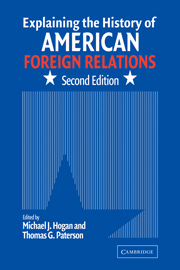Book contents
- Frontmatter
- Contents
- Preface to the Second Edition
- Contributors
- 1 Introduction
- 2 Defining and Doing the History of United States Foreign Relations : A Primer
- 3 Toward a Pluralist Vision : The Study of American Foreign Relations as International History and National History
- 4 Theories of International Relations
- 5 Bureaucratic Politics
- 6 Psychology
- 7 National Security
- 8 Corporatism
- 9 World Systems
- 10 Dependency
- 11 Considering Borders
- 12 The Global Frontier : Comparative History and the Frontier-Borderlands Approach
- 13 Modernization Theory
- 14 Ideology
- 15 Culture and International History
- 16 Cultural Transfer
- 17 Reading for Meaning : Theory, Language, and Metaphor
- 18 What's Gender Got to Do with It? Gender History as Foreign Relations History
- 19 Race to Insight: The United States and the World, White Supremacy and Foreign Affairs
- 20 Memory and Understanding U.S. Foreign Relations
- Index
4 - Theories of International Relations
Published online by Cambridge University Press: 05 June 2012
- Frontmatter
- Contents
- Preface to the Second Edition
- Contributors
- 1 Introduction
- 2 Defining and Doing the History of United States Foreign Relations : A Primer
- 3 Toward a Pluralist Vision : The Study of American Foreign Relations as International History and National History
- 4 Theories of International Relations
- 5 Bureaucratic Politics
- 6 Psychology
- 7 National Security
- 8 Corporatism
- 9 World Systems
- 10 Dependency
- 11 Considering Borders
- 12 The Global Frontier : Comparative History and the Frontier-Borderlands Approach
- 13 Modernization Theory
- 14 Ideology
- 15 Culture and International History
- 16 Cultural Transfer
- 17 Reading for Meaning : Theory, Language, and Metaphor
- 18 What's Gender Got to Do with It? Gender History as Foreign Relations History
- 19 Race to Insight: The United States and the World, White Supremacy and Foreign Affairs
- 20 Memory and Understanding U.S. Foreign Relations
- Index
Summary
Universities and professional associations usually are organized in ways that tend to separate scholars in adjoining disciplines and perhaps even to promote stereotypes of each other and their scholarly endeavors. The seemingly natural areas of scholarly convergence between diplomatic historians and political scientists who focus on international relations have been underexploited, but there are also some signs that this may be changing. These include recent essays suggesting ways in which the two disciplines can contribute to each other; a number of prizewinning dissertations, later turned into books, by political scientists that effectively combine political science theories and historical materials; collaborative efforts among scholars in the two disciplines; interdisciplinary journals such as International Security that provide an outlet for historians and political scientists with common interests; and creation of a new section, “International History and Politics,” within the American Political Science Association.
This essay is an effort to contribute further to an exchange of ideas between the two disciplines by describing some of the theories, approaches, and “models” political scientists have used in their research on international relations during recent decades. A brief essay cannot do justice to the entire range of theoretical approaches that may be found in the current literature, but perhaps those described here, when combined with citations of some representative works, will provide diplomatic historians with a useful, if sketchy, map showing some of the more prominent landmarks in a neighboring discipline.
- Type
- Chapter
- Information
- Explaining the History of American Foreign Relations , pp. 51 - 90Publisher: Cambridge University PressPrint publication year: 2004
- 5
- Cited by



